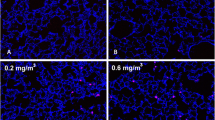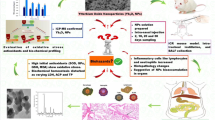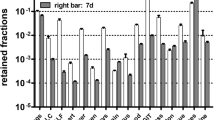Abstract
Chronic inhalation of aerosolized β-N-methylamino-L-alanine (BMAA) could serve as potenital route for exposure to this cyanobacterial neurotoxin implicated in the development of neurodegenerative disease. We investigated environmental aerosol BMAA loads and the fate of inhaled isotopically labeled aerosolized BMAA in adult male Sprague Dawley rats, with doses corresponding to chronic aerosolized environmental BMAA exposure of over 65 days and up to 266 years. Environmental BMAA aerosol concentrations ranged from 6–39 pg L¯1. No clinical signs of toxicity were observed in rats exposed to aerosol containing BMAA at concentrations far exceeding the maximum recorded environmental BMAA aerosol load. Surprisingly, no labeled BMAA was observed in the brain, liver or lung tissues of exposed rats. However, a dose-dependent reduction in the Gln:Glu ratio was observed in brain and liver tissues together with an increase in 2,3 diaminopropanoic acid,15N2, the demethylated L-BMAA-4,4,4-d3,15N2 product, in liver tissues. This confirmed both BMAA uptake and distribution throughout the body. The increase in 2,3 diaminopropanoic acid,15N2 did however not account for the total loss of administered L-BMAA-4,4,4-d3,15N2 and thus, the absence of detectable L-BMAA-4,4,4-d3,15N2 in tissues and feces, together with the absence of other known BMAA catabolites, N-acetylated BMAA and methylamine, additional metabolic reactions are indicated. Significant biochemical responses to BMAA were only observed in doses corresponding to an unrealistic chronic exposure timeframe, suggesting that the inhalation of environmental levels of aerosolized BMAA might not be sufficient to elicit a biochemical response in adults.


Similar content being viewed by others
References
Al-Sammak MA, Hoagland KD, Cassada D, Snow DD (2014) Co-occurrence of the cyanotoxins BMAA, DABA and Anatoxin-a in Nebraska reservoirs, fish and aquatic plants. Toxins (Basel) 6(2):488–508
Backer LC, McNeel SV, Barber T, Kirkpatrick B, Williams C, Irvin M, Zhou Y, Johnson TB, Nierenberg K, Aubel M, LePrell R, Chapman A, Foss A, Corum S, Hill VR, Kieszak SM, Cheng Y-S (2009) Recreational exposure to microcystins during algal blooms in two California lakes. Toxicon:1–13
Bannack SA, Murch SJ (2009) Multiple neurotoxic items in the Chamorro diet link BMAA with ALS/PDC. Amyotroph Lateral Scler 10:34–40
Brand LE (2009) Human exposure to cyanobacteria and BMAA. Amyotroph Lateral Scler 10:85–95
Brand LE, Pablo J, Compton A, Hammerschlag N, Mash DC (2010) Cyanobacterial blooms and the occurrence of the neurotoxin, beta-N-methylamino-L-alanine (BMAA), in South Florida aquatic food webs. Harmful Algae 9(6):620–635
Caller TA, Doolin JW, Haney JF, Murby AJ, West KG, Farrar HE, Ball A, Harris BT, Stommel EW (2009) A cluster of amyotrophic lateral sclerosis in New Hampshire: a possible role for toxic cyanobacterial blooms. Amyotroph Lateral Scler 10(2):101–108
Cheng YS, Zhou Y, Irvin CM, Kirkpatrick B, Backer LC (2007) Characterization of aerosols containing microcystin. Marine Drugs 5:136–150
Contardo-Jara V, Schwanemann T, Pflugmacher S (2014) Uptake of a cyanotoxin β-N-methylamino-L-alanine (BMAA), by wheat (Triticum aestivum). Ecotoxicol Environ Saf 104:127–131
Cox PA, Sacks OW (2002) Cycad neurotoxins, consumption of flying foxes, and ALS-PDC disease in Guam. Neurology 58(6):956–959
Cox PA, Banack SA, Murch SJ, Rasmussen U, Tien G, Bidigare RR, Metcalf JS, Morrison LF, Codd GA, Bergman B (2005) Diverse taxa of cyanobacteria produce β-N-methylamino-L-alanine, a neurotoxic amino acid. Proc Natl Acad Sci U S A 102:5074–5078
Cox PA, Richer R, Metcalf JS, Banack SA, Codd GA, Bradley WG (2009) Cyanobacteria and BMAA exposure from desert dust: a possible link to sporadic ALS among Gulf veterans. Amyotroph Lateral Scler 10:109–117
Cruz-Aguado R, Winkler D, Shaw CA (2006) Lack of behavioral and neuropathological effects of dietary b-methylamino-L-alanine (BMAA) in mice. Pharmacol Biochem Behav 84:294–299
Dietrich DR, Fischer A, Michel C, Hoeger SJ (2008) Toxin mixture in cyanobacterial bloom – a critical comparisonof reality with current procedures employed in human health risk assessment. Cyanobacterial Harmful Algal Blooms: State of the Science and Research Needs Advances in Experimental Medicine and Biology 619:885–912
Downing S, Downing TG (2016) The metabolism of the non-proteinogenic amino acid b-N- methylamino-L-alanine (BMAA) in the cyanobacterium Synechocystis PCC6803. Toxicon 115:41–48
Downing S, Contardo-Jara V, Pflugmacher S, Downing TG (2014) The fate of the cyanobacterial toxin β-N-methylamino-L-alanine in freshwater mussels. Ecotoxicol Environ Saf 101:51–58
Duncan MW, Villacreses NE, Pearson PG, Wyatt L, Rapoport SI, Kopin IJ, Markey SP, Smith QR (1991) 2-amino-3-(methylamino)-propanoic acid (BMAA) pharmacokinetics and blood–brain barrier permeability in the rat. J Pharmacol Exp Ther 258:27–35
Duncan MW, Markey SP, Weick BG, Pearson PG, Ziffer H, Hu Y, Kopin IJ (1992) 2-amino-3-(methylamino)propanoic acid (BMAA) bioavailability in the primate. Neurobio Aging 13:333–337
Haley RW (2003) Excess incidence of ALS in young Gulf war veterans. Neurology 61:750–756
Horner RD, Kamins KG, Feussner JR, Grambow SC, Hoff-Lindquist J, Harati Y (2003) Occurrence of amyotrophic lateral sclerosis among Gulf war veterans. Neuro 61:742–749
Horner RD, Grambow SC, Coffman CJ, Lindquist JH, Oddone EZ, Allen KD (2008) Amyotrophic lateral sclerosis among 1991 Gulf war veterans: evidence for a time-limited outbreak. Neuroepidemiology 31:28–32
Jiang L, Kiselova N, Rosén J, Ilag LL (2014) Quantification of neurotoxin BMAA (β-N-methylamino-L-alanine) in seafood from Swedish markets. Scientific reports 4:6931
Johnson HE, King SR, Banack SA, Webster C, Callanaupa WJ, Cox PA (2008) Cyanobacteria (Nostoc commune) used as a dietary item in the Peruvian highlands produce the neurotoxic amino acid BMAA. J Ethnopharmacol 118(1):159–165
Jonasson S, Eriksson J, Berntzon L, Spáčil Z, Ilag LL, Ronnevi L-O, Rasmussen U, Bergman B (2010) Transfer of a cyanobacterial neurotoxin within a temperate aquatic ecosystem suggests pathways for human exposure. Proc Natl Acad Sci U S A 107(20):9252–9257
Karlsson O, Berg C, Brittebo EB, Lindquist NG (2008) Retention of the cyanobacterial neurotoxin b-N-methylamino-L-alanine in melanin and neuromelanin-containing cells – a possible link between Parkinson-dementia complex and pigmentary retinopathy. Pigment Cell Melanoma Res 22:120–130
Karlsson O, Lindquist NG, Brittebo EB, Roman E (2009) Selective brain uptake and behavioral effects of the cyanobacterial toxin BMAA (ß-N-methylamino-L-alanine) following neonatal administration to rodents. Toxicol Sciences 109(2):286–295
Karlsson O, Berg A-L, Lindstrom A-K, Arnerup G, Roman E, Bergquist J, Hanrieder J, Lindquist NG, Brittebo EB, Andersson M (2012) Neonatal exposure to the cyanobacterial toxin BMAA induces changes in protein expression, and neurodegeneration in adult hippocampus. Toxicol Sciences 130(2):391–404
Kastin AJ, Kuzemchak B, Tompkins RG, Schally AV, Millder MC (1976) Melanin in the rat brain. Brain Res Bull 1(6):567–572
Kastin AJ, Kuzemchak B, Schally AV, Eggert MW (1979) Rat brain melanin at different ages and after various treatments. Brain Res Bull 4(6):793–797
Kosenko E, Llansola M, Montolui C, Monfort P, Rodrigo R, Hernandez-Viadel M, Erceg S, Sanchez-Perez AM, Felipo V (2003) Glutamine synthetase activity and glutamine content in the brain: modulation by NMDA receptors and nitric oxide. Neurochem Int 43:493–499
Lage S, Annadotter H, Rasmussen U, Rydberg S (2015) Biotransfer of β-N-methylamino-L-alanine (BMAA) in a Eutrophicated freshwater Lake. Mar Drugs 13(3):1185–1201
Mondo L, Hammerschlag N, Basile M, Pablo J, Banack SA, Mash DC (2012) Cyanobacterial neurotoxin β-N-methylamino-L-alanine (BMAA) in shark fins. Mar Drugs 10(2):509–520
Mondo K, Glover BW, Murch SJ, Liu G, Cai Y, Davis DA, Mash DC (2014) Environmental neurotoxins β-N-methylamino-L-alanine (BMAA) and mercury in shark cartilage dietary supplements. Food Chem Toxicol 70:26–32
Morris JG Jr (1999) Pfiesteria, ‘the cell from hell’, and other toxic algal nightmares. Clin Infect Dis 28:1191–1196
Murch SJ, Cox PA, Banack SA (2004) A mechanism for slow release of biomagnified cyanobacterial toxins and neurodegenerative disease in Guam. Proc Natl Acad Sci 101:12228–12231
Neumiller JJ, Campbell RK, Wood LD (2010) A review of inhaled technosphere insulin. Ann Pharmacother 44(7–8):1231–1239
Nunn RB, Ponnusamy M (2009) BMAA: metabolism and metabolic effects in model systems and in neural and other tissues of the rat in vitro. Toxicon 54:85–94
Patton JS, Byron PR (2007) Inhaling medicines: delivering drugs to the body through the lungs. Nat Rev Drug Discov 6:67–74
Perry TL, Bergeron C, Biro AJ, Hansen S (1989) Chronic oral administration of b-N-methylamino-L-alanine is not neurotoxic to mice. J Neurol Sci 94:173–180
Pierce RH, Henry MS, Blum PC, Lyons J, Cheng YS, Yazzie D, Zhou Y (2003) Brevetoxin concentrations in marine aerosol: human exposure levels during a Karenia brevis Harmful algal bloom. Bull Environ Contam Toxicol 70(1):161–165
Polsky FI, Nunn PB, Bell EA (1972) Distribution and toxicity of aamino-b-methylaminopropionic acid. Fed Proc 31:1473–1475
Rao SD, Banack SA, Cox PA, Weiss JH (2006) BMAA selectively injures motor neurons via AMPA/kainite receptor activation. Exp neurology 201:244–252
Reece DM, Nunn PB (1989) Synthesis of 14C-labelled L-α-amino-β-methylaminopropionic acid and its metabolism in the rat. Biochem Soc Trans 17:203–204
Reveillon D, Abadie E, Sechet V, Masseret E, Hess P, Amzil Z (2015) β-N-methylamino-L-alanine (BMAA) and isomers: distribution on different food web compartments of Thau lagoon, French Mediterranean Sea. Mar Environ Res 110:8–18
Reveillon D, Sechet V, Hess P, Amzil Z (2016) Systemic detection of BMAA (β-N-methylamino-L-alanine) and DAB (2,4-diaminobutyric acid) in mollusks collected in shellfish production areas along the French coasts. Toxicon 110:35–46
Rosenstock J, Lorber DL, Gnudi L (2010) Prandial inhaled insulin plus insulin glargine versus twice daily biaspart insulin for type 2 diabetes:a multicentre randomized trial. Lancet 375:2244–2253
Salem H, Katz SA (2006) Inhalation toxicology, Second edn. Taylor & Francis Group, USA
Seawright AA, Brown AW, Nolan CC, Cavanagh JB (1990) Selective degeneration of cerebellar cortical neurons caused by cycad neurotoxin L-β-methylaminoalanine (BMAA), in rats. Neuropathol Appl Neurobiol 16:153–169
Su X, Xue Q, Steinman AD, Zhao Y, Xie L (2015) Spatiotemporal dynamics of microcystin variants and relationships with environmental parameters in Lake Taihu, China. Toxins 7(8):3224–3244
Takenaka S, Möller W, Semmler-Behnke M, Karg E, Wenk A, Schmid O, Stoeger T, Jennen L, Aichler M, Walch A, Pokhrel S, Mädler L, Eickelberg O, Kreyling WG (2012) Efficient internalization and intracellular translocation of inhaled gold nanoparticles in rat alveolar macrophages. Nanomedicine 7(6):855–865
Weiss JH, Christine CW, Choi DW (1989) Bicarbonate dependence of glutamate receptor activation by β-N-methylamino-L-alanine: channel recording and study with related compounds. Neuron 3:321–326
Acknowledgements
The authors acknowledge the National Research Foundation of South Africa for financial support. The authors would also like to acknowledge Leopold Ilag and Nadezda Zguna of the Department of Environmental Science and Analytical Chemistry, Stockholm University, for the use of equipment used in environmental aerosol sample analysis.
Author information
Authors and Affiliations
Corresponding author
Ethics declarations
Ethical Approval
All applicable international, national, and/or institutional guidelines for the care and use of animals were followed. All procedures performed in studies involving animals were in accordance with the ethical standards of the institution or practice at which the studies were conducted.
Conflict of Interests
The authors declare that they have no conflict of interest.
Rights and permissions
About this article
Cite this article
Scott, L.L., Downing, S. & Downing, T.G. The Evaluation of BMAA Inhalation as a Potential Exposure Route Using a rat Model. Neurotox Res 33, 6–14 (2018). https://doi.org/10.1007/s12640-017-9742-9
Received:
Revised:
Accepted:
Published:
Issue Date:
DOI: https://doi.org/10.1007/s12640-017-9742-9




